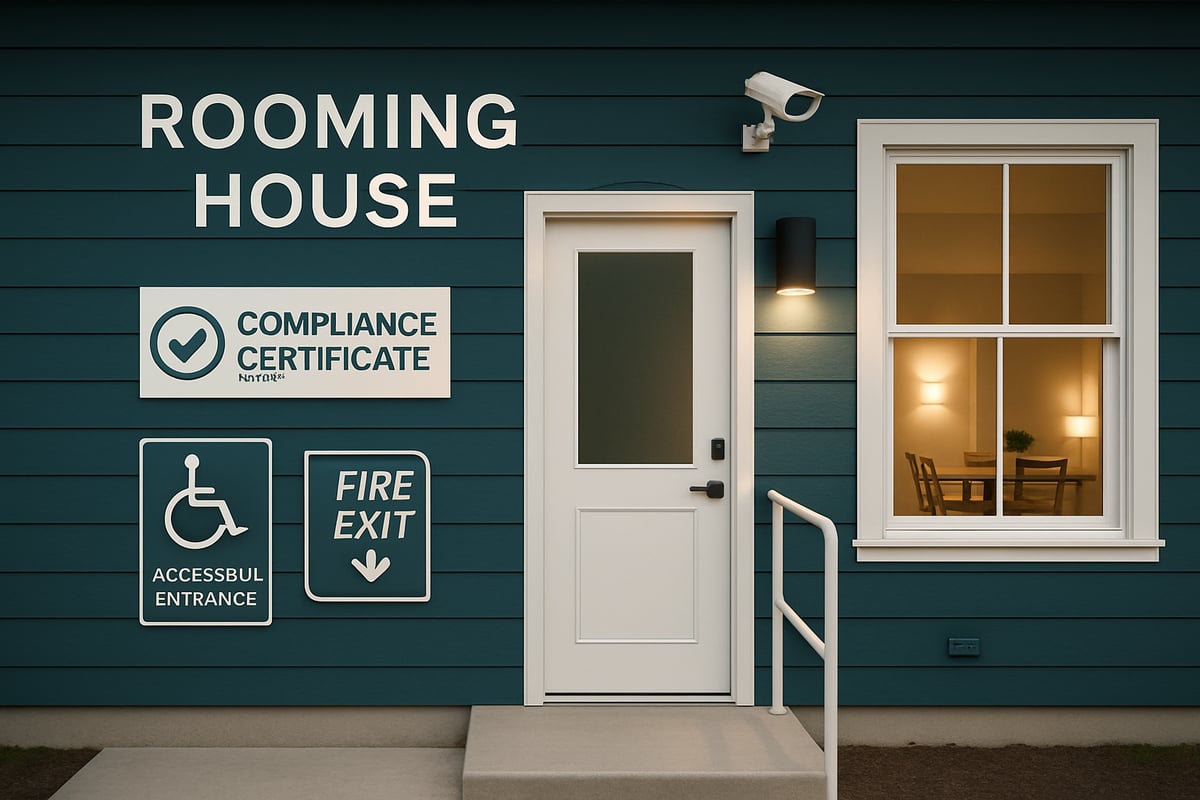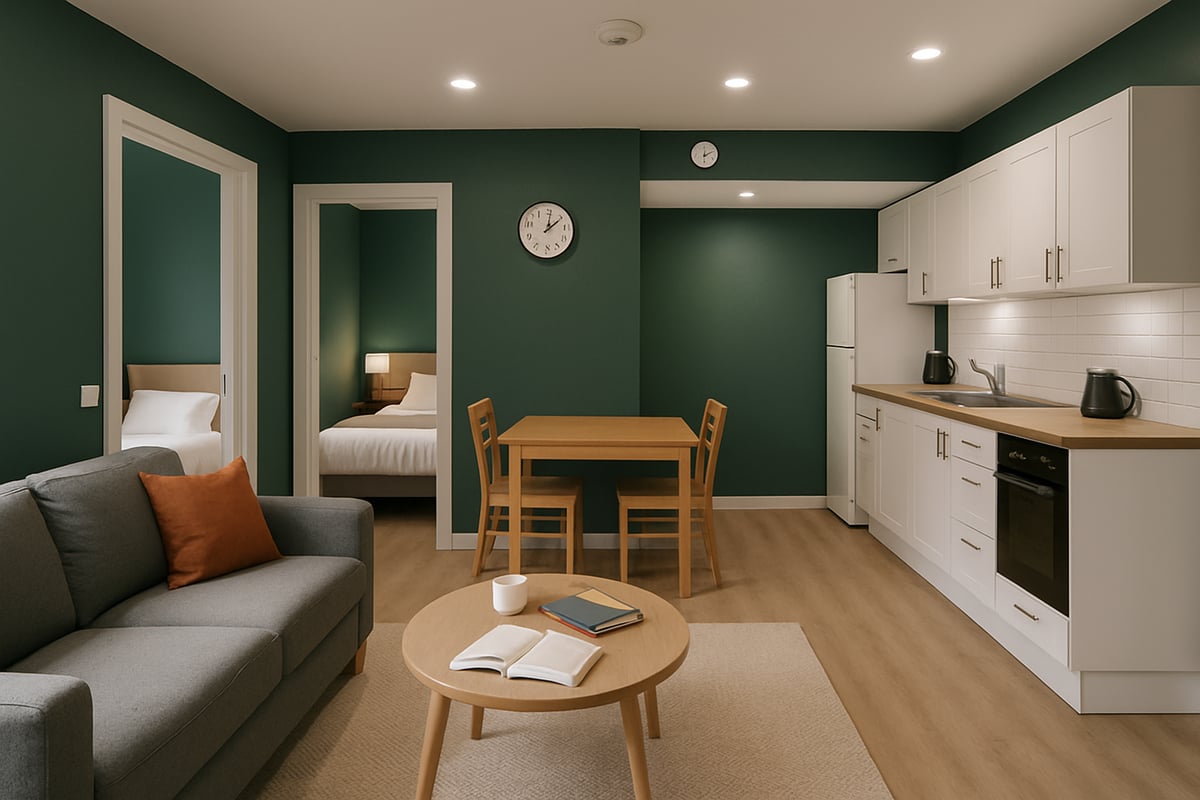Rooming houses are quickly becoming one of the highest-yielding, most resilient property strategies for 2025. However, true success in rooming house investment takes more than just ticking boxes or meeting minimum standards.
This comprehensive guide reveals proven, actionable strategies to help you maximize your returns in the evolving 2025 market. You’ll discover essential fundamentals, the latest market trends, legal and compliance essentials, step-by-step investment strategies, design and management best practices, risk mitigation tips, and a future outlook.
Ready to outperform the competition? Equip yourself with expert tactics and confidently invest in rooming houses in 2025.
Understanding Rooming House Investments: Fundamentals and Market Drivers
Rooming house investment is quickly gaining traction as a leading strategy within the property sector. Investors are drawn to its unique model, which blends high-yield opportunities with diversified cash flow. To unlock its full potential in 2025, it is essential to understand the fundamentals, market drivers, and the investor profiles best suited for this approach.

Defining Rooming Houses and Their Investment Potential
A rooming house is a property where multiple tenants rent individual rooms, often on separate leases, while sharing common spaces like kitchens and living areas. Unlike traditional rentals or multifamily units, rooming houses cater to those seeking affordability and flexibility. Tenant profiles in 2025 include students, young professionals, and shift workers who value cost-effectiveness and communal living.
The main appeal of rooming house investment lies in its ability to generate several income streams from a single property. For example, savvy investors have reported gross yields of 10 to 15 percent, far surpassing the 4 to 6 percent from standard rentals. According to rental investment fundamentals, demand for affordable, flexible housing continues to rise, further strengthening the case for this investment strategy.
Key Market Trends Shaping Rooming House Investments in 2025
Rooming house investment is being propelled by several powerful trends. The rental affordability crisis is deepening, with major cities experiencing record shortages and rising rents. Urban migration patterns fuel demand for shared housing, as individuals seek proximity to work and amenities without the burden of high lease costs.
Governments are responding with incentives and policy shifts, making it easier to operate compliant rooming houses. The growth in single-person households and evolving tenant preferences mean rooming houses are now viewed as desirable, not as a last resort. Some metropolitan regions have seen double-digit increases in rooming house occupancy rates, highlighting this shift.
Advantages and Challenges of Rooming House Investments
The key strengths of rooming house investment include high rental yields, steady cash flow, and reduced vacancy risk due to a diverse tenant base. Investors also find satisfaction in contributing to social outcomes by providing affordable housing options.
However, this strategy is not without challenges. Rooming houses require more intensive management, are subject to regulatory scrutiny, and can experience higher tenant turnover. Testimonials from investors often cite the rewarding profits but caution that complexity and compliance are part of the journey.
Comparison Table: Rooming Houses vs Standard Rentals
| Feature | Rooming House | Standard Rental |
|---|---|---|
| Yield | 10-15% | 4-6% |
| Vacancy Risk | Low | Moderate |
| Management Intensity | High | Low |
| Social Impact | High | Low |
Who Should Consider Rooming House Investments?
Rooming house investment is ideal for hands-on property managers, impact-driven investors, and those seeking strong, consistent cash flow. Successful investors typically have moderate to high risk tolerance and a willingness to navigate regulatory requirements.
Portfolio diversification is another significant benefit. To self-assess readiness, ask yourself:
- Am I willing to actively manage tenants and compliance?
- Do I have the capital for potential upgrades?
- Is my risk tolerance suited to a dynamic environment?
Profiles of successful investors include those who transitioned from single-family rentals to rooming houses, citing improved returns and greater satisfaction. If you meet these criteria, rooming house investment could be your next strategic move.
Legal, Regulatory, and Compliance Essentials for 2025
Understanding the legal and regulatory landscape is absolutely essential for successful rooming house investment in 2025. With evolving legislation and heightened scrutiny, investors must go beyond the basics to protect their assets and maximize returns. This section explores zoning, compliance, tenancy law, and insurance—so you can confidently navigate the complexities of rooming house investment.

Navigating Local Zoning, Permits, and Legal Classifications
Zoning laws are the foundation of every rooming house investment. Each city or state defines rooming houses differently, with regulations covering occupancy limits, parking, and communal amenities. Before you purchase or convert a property, verify it is zoned for shared accommodation. Securing the correct permits and licenses is mandatory—failure to comply can result in hefty fines or forced closure.
For example, a Melbourne investor lost months of income after their property was shut down for zoning violations. Always consult local council resources and legal experts during your due diligence. For a deeper dive into these regulatory aspects and practical guidance, see this Rooming House Investment Strategy.
Health, Safety, and Building Code Standards
Compliance with health and safety codes is non-negotiable for any rooming house investment. Building standards now require advanced fire safety, multiple emergency exits, and accessible design features. Minimum room sizes, proper ventilation, and sanitation are closely monitored by inspectors.
In 2025, new regulations have increased requirements for accessibility and disability compliance. Many investors are upgrading properties to include fire-rated doors, sprinkler systems, and improved air filtration. Staying ahead of these codes protects both your tenants and your investment.
Tenancy Law, Lease Structures, and Occupancy Limits
Rooming house investment requires a different approach to leases compared to traditional rentals. Individual tenancy agreements for each resident are standard, with strict rules on maximum occupancy and privacy. Landlords must know the rights and responsibilities unique to shared accommodation, which can vary significantly by jurisdiction.
Disputes and evictions in rooming houses can be more complex, so clear house rules and transparent documentation are crucial. In Sydney, for example, new legislation introduced in 2024 mandates specific notice periods and dispute resolution procedures for rooming houses.
Insurance and Liability Considerations
A robust insurance strategy protects your rooming house investment from unexpected events. Standard property insurance is not enough—you will need specialized landlord and public liability coverage tailored to multi-tenant properties. This is vital for covering risks like fire, injury, or property damage.
Claims unique to rooming houses, such as those related to shared spaces or tenant disputes, can be costly. Compare policies carefully, considering both premium costs and coverage limits. Use a comprehensive checklist to ensure all regulatory and practical risks are covered before onboarding tenants.
Step-by-Step Investment Strategy: From Property Selection to Tenant Onboarding
Ready to master the rooming house investment process? This step-by-step strategy will guide you from choosing the right location to onboarding tenants, ensuring your investment is set up for maximum yield in 2025.

Identifying Profitable Rooming House Locations
The foundation of a successful rooming house investment is selecting the right location. Start by analyzing local rental demand, vacancy rates, and tenant demographics. Look for areas near universities, hospitals, transport hubs, and employment centers — these hotspots attract a steady tenant pool.
Use data-driven tools to compare suburbs and cities. For example, Sydney’s inner west, Melbourne’s northern suburbs, and Brisbane’s inner city are projected to offer strong returns in 2025. Avoid regions with council restrictions or market oversaturation.
A simple comparison table can help you shortlist your options:
| City/Suburb | Vacancy Rate | Median Rent | Rooming House Regulations |
|---|---|---|---|
| Sydney Inner West | 2.1% | $350/wk | Supportive |
| Melbourne North | 1.8% | $310/wk | Permissive |
| Brisbane Inner City | 2.3% | $330/wk | Favorable |
Successful rooming house investment begins with finding locations that balance demand, favorable regulations, and growth potential.
Assessing and Acquiring Suitable Properties
Once you have your target area, focus on properties with the right size, layout, and zoning for rooming house investment. Large houses with multiple bathrooms and living spaces, or small apartment blocks, are ideal.
Evaluate whether to convert an existing property or purchase one already operating as a rooming house. Always conduct thorough due diligence — check structural integrity, zoning compliance, and financial viability.
A due diligence checklist should include:
- Building inspection
- Compliance with local regulations
- Financial projections
- Title and ownership checks
Negotiation is key. Look for motivated sellers or properties with value-add potential. For a deeper dive into building your strategy, see this comprehensive Property investment strategy guide.
Renovation, Conversion, and Fit-Out Best Practices
Transforming a standard property into a high-performing rooming house investment requires smart renovation choices. Prioritize cost-effective upgrades that boost yield, like adding ensuites, soundproofing, and creating defined communal spaces.
Optimize the layout for privacy and comfort. Use durable, easy-to-clean materials for high-traffic areas. Ensure all renovations comply with 2025 building codes, including fire safety and accessibility.
A recent conversion example: An investor spent $80,000 reconfiguring a six-bedroom home, resulting in a 12% gross yield. Careful planning and budgeting kept the project on track and maximized ROI.
Financial Modeling, Cash Flow, and ROI Analysis
Before you commit, run detailed financial models for your rooming house investment. Calculate total acquisition and renovation costs, projected rental income, and ongoing expenses.
Factor in conservative vacancy and turnover rates for realistic projections. Use sensitivity analysis to understand how changing interest rates or market conditions could impact your returns.
Here’s a basic sample pro forma for a six-room property:
Total Costs: $950,000 purchase + $100,000 renovations
Gross Monthly Rent: $4,200
Expenses: $1,400/month
Net Yield: 10.5%
Leverage investment calculators and scenario tools to validate your numbers.
Tenant Targeting, Screening, and Onboarding
Rooming house investment success hinges on finding and retaining the right tenants. Define your ideal tenant profile — students, professionals, healthcare workers — and tailor your marketing accordingly.
Use online platforms, social media, and local partnerships to attract applicants. Screen for reliability, financial stability, and compatibility with shared living. A structured onboarding process, including clear house rules and orientation, helps reduce turnover.
For example, one investor decreased annual turnover by 30% after refining their tenant screening and onboarding process.
Property Management Systems and Technology
Efficient management is crucial for scalable rooming house investment. Automate rent collection, maintenance requests, and communication using property management software designed for shared housing.
Decide whether to self-manage or outsource. Outsourcing can save time but reduces direct control. Track key metrics like occupancy, arrears, and maintenance costs for operational efficiency.
By embracing digital tools, one rooming house investor reduced vacancy rates by 15% and minimized disputes. Technology streamlines processes and supports sustainable portfolio growth, making your rooming house investment future-ready.
Design, Quality, and Value-Add Strategies for Maximum Returns
Delivering maximum returns from your rooming house investment requires more than meeting the bare minimum. Focusing on design, quality, and strategic value-adds sets your property apart, attracts better tenants, and enhances long-term profitability.

Creating Desirable, High-Quality Living Spaces
Exceeding “good enough” transforms your rooming house investment into a top choice for tenants. Modern design emphasizes privacy, comfort, and functionality. Soundproofing between rooms, lockable doors, and thoughtful layouts reduce friction.
Furnishing each room with quality beds, desks, and storage increases appeal. Upgraded communal kitchens and bathrooms with durable finishes attract professionals seeking comfort.
A recent example: a Melbourne investor boosted occupancy and tenant retention by redesigning communal spaces for better natural light and adding premium appliances. These improvements led to higher rent per room and fewer vacancies.
Health, Safety, and Wellbeing Enhancements
Health and safety are non-negotiable for a successful rooming house investment. In 2025, air quality, lighting, and ergonomic design are top priorities. Install air purifiers, ensure ample natural and LED lighting, and select ergonomic furniture.
Security improvements, such as smart locks and CCTV, provide peace of mind. Fire safety upgrades, including smoke alarms in every room and clear emergency exits, are essential.
Creating community spaces while preserving privacy supports mental wellbeing. Wellness-focused upgrades, like quiet study areas and fitness corners, have led to longer tenancies and better tenant feedback.
Sustainability and Cost-Saving Upgrades
Sustainability is both a value-add and a cost-saver for any rooming house investment. Energy-efficient appliances, LED lighting, and solar panels reduce utility bills, benefiting both owner and tenant.
Water-saving fixtures and recycling systems are increasingly expected by environmentally conscious renters. Governments may offer grants or rebates for green retrofits, lowering your upfront investment.
A Sydney landlord saw operating costs drop 20 percent after installing solar and water-saving devices. These upgrades also made the property more attractive to eco-minded tenants. For more ideas, review Maximizing Rental Property ROI in 2025.
Differentiation and Tenant Experience
Branding your rooming house investment as a premium option pays off. Offer value-added services like high-speed internet, regular cleaning, or community events. These features drive word-of-mouth referrals and positive reviews.
Host social gatherings or shared interest groups to foster community, but respect privacy with clear house rules.
A case study from Brisbane: one investor’s focus on tenant experience resulted in a waiting list, while competitors struggled with vacancies. Outperforming those who only meet minimum standards is the secret to long-term stability and growth.
Risk Management, Pitfalls, and How to Avoid Common Mistakes
Investing in rooming houses offers exceptional returns, but it comes with unique risks. Effective risk management is essential for rooming house investment success. By understanding common pitfalls and how to avoid them, you can protect your cash flow and reputation while building a resilient portfolio.
Common Challenges and How to Overcome Them
Rooming house investment often faces challenges that differ from standard rentals. High tenant turnover and frequent vacancies can disrupt income streams. Managing noise, conflict, and community dynamics also requires proactive strategies.
- Address tenant issues early to prevent escalation.
- Regularly inspect properties to catch maintenance needs before they become costly.
- Foster a sense of community to reduce conflict and improve retention.
For example, some investors report using monthly meetings and clear house rules to minimize disputes. Insights from platforms like BiggerPockets show that open communication and structured onboarding are key to long-term stability in rooming house investment.
Legal and Regulatory Pitfalls
Rooming house investment is subject to strict legal and regulatory standards. Mistakes in compliance, such as missing permits or inadequate safety measures, can lead to steep fines or even forced closure.
- Double-check all licensing and building code requirements.
- Stay updated on local tenancy laws to avoid unintended breaches.
- Maintain detailed records for inspections and tenant interactions.
A real-world example involves an investor fined and shut down due to overlooked occupancy limits. Preventative checklists and continuous legal education are essential. Always consult professionals before making changes to your rooming house investment.
Financial Risks and Cash Flow Shocks
Financial surprises are a leading cause of stress in rooming house investment. Unexpected repair costs, dips in rental demand, or rising interest rates can quickly erode profits.
- Build an emergency fund to cover sudden expenses.
- Use conservative estimates in your cash flow projections.
- Regularly stress-test your investment plan for worst-case scenarios.
Many successful investors also diversify by exploring home rental investment strategies to balance risk. Comprehensive insurance is another must-have for every rooming house investment.
Reputation, Tenant Selection, and Community Relations
Your reputation is your currency in rooming house investment. Poor tenant screening can lead to late payments, property damage, or neighborhood complaints. Proactive engagement with both tenants and local communities is vital.
- Screen tenants thoroughly for compatibility and reliability.
- Address complaints promptly and transparently.
- Build positive relationships with neighbors and local councils.
A case study shows that investors who host community events and maintain transparent communication often turn initial skepticism into positive word-of-mouth. These strategies help ensure the long-term success of your rooming house investment.
The Future of Rooming House Investment: Trends, Innovations, and Opportunities
As the property landscape evolves, rooming house investment is set to benefit from powerful trends and fresh opportunities. Investors who anticipate shifts in tenant preferences, embrace new technology, and understand policy changes will be best placed to thrive. Let’s look ahead to what’s shaping the future.
Evolving Tenant Expectations and Demographics
Tenant expectations for rooming house investment are rapidly changing. In 2025, more people are seeking flexible, affordable housing that feels like home. Remote workers, students, and professionals want fast internet, furnished rooms, and communal spaces for socializing or work.
Recent surveys show a growing preference for short-term leases and all-inclusive pricing. As highlighted in Rental Property Trends for 2025, amenities like high-speed Wi-Fi, in-unit laundry, and modern security are now standard. Investors who tailor their rooming house investment to these needs can achieve higher occupancy and attract long-term tenants.
Technology and Smart Building Integration
Smart technology is revolutionizing rooming house investment management. Automated systems handle rent collection, maintenance requests, and tenant communications, reducing manual workload and errors.
Smart locks and surveillance systems improve security and give tenants peace of mind. Property management platforms streamline operations, making it easy to monitor occupancy and expenses in real time. Some investors are even using AI-powered tools to match compatible housemates, enhancing tenant satisfaction and minimizing turnover. Embracing these innovations positions your rooming house investment ahead of the competition.
Policy, Incentives, and Impact Investing
Government incentives for affordable housing are expanding, giving rooming house investment a boost. Tax breaks, grants, and low-interest loans are available for properties that meet energy efficiency and accessibility standards.
Rooming houses are increasingly seen as solutions to housing shortages, and investors can leverage impact funds or ESG criteria to access new capital sources. Keeping up with local policies helps you tap into these incentives and ensures your rooming house investment remains compliant and profitable.
Scaling Your Rooming House Portfolio
Scaling a rooming house investment portfolio requires clear strategy and the right team. Once your first property runs smoothly, consider expanding to additional locations or cities with high demand.
Successful investors often build relationships with experienced property managers, maintenance teams, and legal advisors to support growth. As discussed in Emerging Real Estate Investment Options 2025, diversifying across property types strengthens your portfolio and spreads risk. Focus on maintaining quality and strong tenant relationships as you scale your rooming house investment.
You have seen how rooming houses can offer standout returns, steady cash flow, and a real impact on affordable housing, but the key is taking action with the right strategy. If you are ready to explore how these smart investment moves could fit your goals, especially using your superannuation for long-term growth, it helps to have an expert guide by your side. Let us help you identify the best opportunities, navigate the details, and set yourself up for a confident retirement.
Start Building Your Wealth—Speak With an Expert




